Create a free profile to get unlimited access to exclusive videos, sweepstakes, and more!
This prehistoric shark looked like a deranged Rick Sanchez, but its teeth were the real nightmare

When Rick can’t get his Szechuan sauce (or his way), you know how terrifying he gets—but he’s not the only creature to ever have enormous eyeballs and a mouth full of sharp teeth.
Ferromirum oukherbouchi looks like it swam straight out of Rick and Morty. It could pass as another thing for Rick to morph into besides Pickle Rick, but unlike the animated mad scientist, this extinct shark actually existed. This newly discovered species had disproportionately huge eyes that were frightening enough, but that wasn’t even the real killer. Its jaws were something like a warped chainsaw that rotated inward when it closed its mouth and outward when it opened it. It was also constantly growing new teeth. Rick hasn’t yet figured out a formula to give himself that superpower.
Extant sharks that stalk through the seas today are constantly replacing their old teeth with new teeth. F. oukherbouchi hoarded all its teeth, with new sharp ones growing next to the older and more worn ones, so it could sink as many as possible into its next unsuspecting meal. Newer and sharper teeth pointed inwards and were not visible with a closed mouth, but stood upright when the lower jaw rotated in a particularly strange way. When F. oukherbouchi clamped its jaws down on prey, both jaws rotated all its teeth outward to keep dinner from moving. This lethal arrangement of teeth made it easier for the shark to snap up something when it was hungry. Prey would meet a grim end.
An international team of paleontologists who studied its 370-million-year-old remains are still in awe, and not just because shark skeletons, which are made of cartilage, don’t hold up nearly as well as bone, which fossilizes. Nothing like this has been seen in any living fish.
So many questions. If you can get the teeth our of your mind and your potential nightmares for a second, how did it get those Jeepers Creepers eyes?
"Remarkably, the eyes of most early relatives of today's chimaeras (cartiligenous fish related to sharks) had large eyes. Like in other groups with big eyes, such as some squid and the extinct ichthyosaurs, one can assume that indeed these eyes permitted seeing better in low light conditions," paleontologist Chrsitian Klug, who recently co-authored a study published in Communications Biology told SYFY WIRE. "However, we cannot test this hypothesis directly because the new species is extinct."
CT scans revealed parts of the Devonian shark’s jaw that were then reconstructed by Frey’s team and then 3D-printed. The 3D model gave them the opportunity to try out the jaw and see just how it caught and trapped prey (no fish were harmed in the testing of this model). Humans have a lower jaw with both sides fused together in the middle. Because the jaws of F. ourkherbouchi did not show this fusion, this told the researchers that the terror fish could drop both halves of their lower jaw downward while rotating them outwards automatically. Besides being able to knife prey more effectively with its teeth, the inward rotation of the shark’s lower jaw would shove prey deeper into its mouth.
As if F. oukherbouchi wasn’t already nightmarish enough, its rotating jaw made it capable of suction feeding. When its jaws opened and the lower jaw pushed outward, sea water gushed into its mouth, and slamming its mouth shut would cause an intense pull that made it almost impossible for prey to escape.
"For aquatic predators, suction is quite important, especially for smaller prey. In living sharks and chimaeras, suction feeding occurs, but their jaws are organized differently," Klug said. "It is a question of further research that needs to question what aspects of the Devonian jaw construction are retained in the jaws of modern cartilaginous fish and which parts might have evolved convergently towards suction. The jaw of the snaggletooth shark shows a similar rotation of the jaw but has a quite different jaw articulation, which suggests a convergent evolution of jaw rotation."
So why did such a ferocious predator end up going extinct? Other species that have been previously studied displayed similar jaw characteristics to F. oukherbouchi, but this was the first among such specimens that was studied in 3D to understand the variance in species that shared the same waters. The constant replacement of teeth that made F. oukherbouchi such an effective killing machine would eventually fall out of use. Sharks would slow down and grow their teeth back less often. While F. oukherbouchi’s jaw is thought to have ruled the oceans during the Paleozoic Era, especially the Devonian period, sharks would go on to evolve even weirder jaws. Klug has an idea how that happened.
"I believe that the jaw mechanisms of the earliest elasmobranch sharks might have been similar to those of early chimaeran relatives, though whether they were is still unknown," he said. "In any case, today's elasmobranchs show a broad range of different jaw constructions and dentitions, reflecting an ecological diversification that took place long after the demise of F. oukherbouchi, with the modern forms feeding on many different types of prey."
Maybe Pickle Rick will evolve into Extinct Killer Shark Rick someday.


























